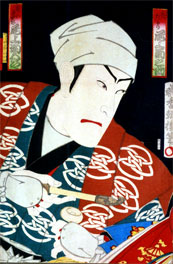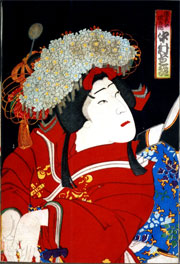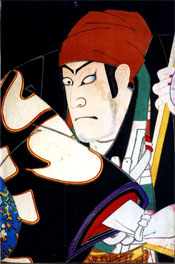| MODORI KAGO |
| Dance title | Modori Kago Modori Kago Iro ni Aikata |
| Authors | Sakurada Jisuke I (lyrics) Tobaya Rich˘ I (music) Nishikawa Senz˘ II, Ichiyama Shichijűr˘ I (choreography) |
| History |
The dance-drama "Modori Kago Iro ni Aikata" was premiered in the 11th lunar month of 1788 at the Nakamuraza [casting], within Sakurada Jisuke I's kaomise program "T˘zum˘ Hana no Edokata", which celebrated the homecoming to Edo, after two years' absence, of Nakamura Nakaz˘ I, and was intended to show off his particular talents in the role of Jirosaku (in reality Ishikawa Goemon). |
| Length |
Around 37 minutes. |
| Key words |
Ishikawa Goemon Ishikawa-goemonmono Kago Kagokaki Kamuro Kaomise Buy˘ Kuruwa Naniwa Sakura Shimabara Shinmachi Shin-Yoshiwara Shosagoto Taik˘ki Tokiwazu |
| Summary |
A palanquin stops by a country roadside, so the two bearers can have a rest. The bearer Yoshir˘, who is from Edo (T˘ky˘), is a refined man, but his companion Jirosaku, from Naniwa (ďsaka), is rather more uncouth. They admire the cherry blossom, have a smoke, and then speculate as to the identity of their passenger. Jirosaku says he believes she is a kamuro, an apprentice to a famous Ky˘to courtesan. Both men are intrigued enough to want to see her, and call her out. She emerges from the palanquin and chats to the two bearers about the place in which they've stopped. The men begin to feel randy in the presence of such an embodiment of the Pleasure Quarters, and when Yoshir˘ announces that he's in the mood for a courtesan, Jirosaku announces that he's met one in Naniwa's Shinmachi district. Aided and abetted by the kamuro, who lets him wear a haori coat (a present from the girl's mistress to her patron) and acts as his attendant, Jirosaku swaggers about in imitation of a samurai on a night-time visit, using the palanquin bearers' travelling sticks as the samurai's two swords. Next it is Yoshir˘'s turn to describe an adventure in the Pleasure Quarters. In contrast, he pretends to be a lowly yakko footman who has been sent to the area on an errand for his master. Finally, it is the kamuro's turn, and she enacts some of her own experiences in the Shimabara Quarter of Ky˘to, bringing out the bitterness of the kamuro's lot. The game continues as Yoshir˘ is asked to show life in the famous Shin-Yoshiwara Pleasure Quarter of Edo. But Yoshir˘ has to admit that he's never patronised anywhere this glamorous. His limit has been the cheap brothels, and he accordingly mimes visiting such a low dive, with a scarf over his head to help to conceal his identity. He is joined by the kamuro, who plays the prostitute. Things are more relaxed (and more basic) at this end of the spectrum than in the high class establishments, and the girl feigns unwillingness to let the man say farewell. Jirosaku then decides to teach Yoshir˘ what upmarket Houses of Pleasure are like, and, with the kamuro as a servant, Yoshir˘ follows Jirosaku's instructions and portrays a courtesan. The two men really enjoy the playacting, and again swap roles, with Jirosaku using the warimi technique to portray a very unlikely courtesan to comic effect. Things get a bit rough, and in the course of the horseplay, each finds an object hidden in the other's kimono which reveals its owner's true identity. Yoshir˘, who is really the noble general Mashiba Hisayoshi, has a precious incense burner, and Jirosaku, who in reality is the notorious bandit Ishikawa Goemon, has a scroll giving the names of plotters against the government. The two are sworn enemies, and the general has been pursuing the bandit for some time. It is mere chance that in the course of this pursuit both have disguised themselves as palanquin bearers, and found themselves carrying the same palanquin - without, of course, recognising one another! The two fight, with swords which have been concealed inside their palanquin bearers' sticks, but, with the kamuro trying to part them, the fight is inconclusive, leaving them with the necessity of battling it out another day. Summary written by Marion Hudson (October 2012). |
 |
 |
 |
|
The actors Onoe Kikugor˘ V, Onoe Kikunosuke II and Nakamura Shikan IV playing the roles of Azuma no Yoshir˘, the kamuro and Naniwa no Jirosaku in the dance-drama "Modori Kago Iro ni Aikata", which was staged in June 1891 at the Ichimuraza (print made by K˘ch˘r˘ H˘sai) |
||
|
|
| Contact | Main | Top | Updates | Actors | Plays | Playwrights | Programs | Links | FAQ | Glossary | Chronology | Illustrations | Prints | Characters | Derivatives | Theaters | Coming soon | News |